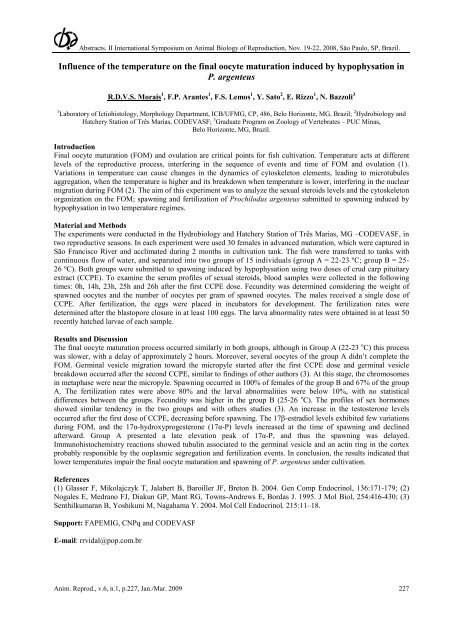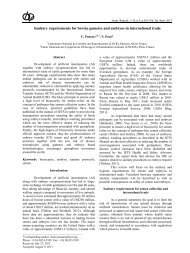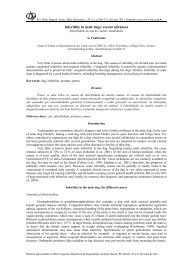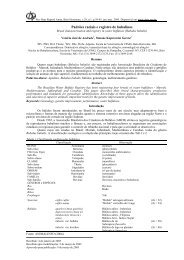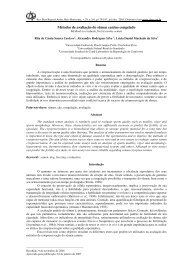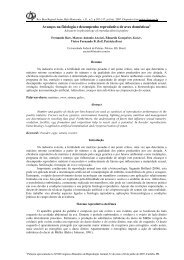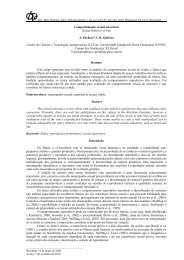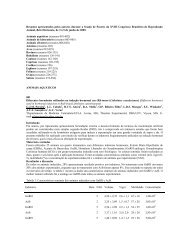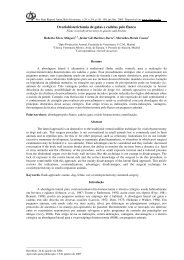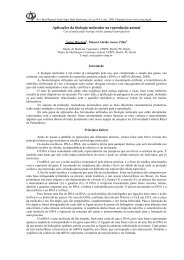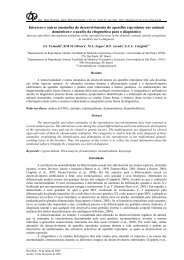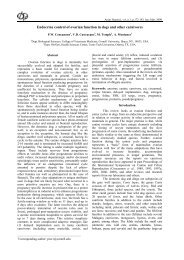Recent advances in ovulation synchronization and superovulation in ...
Recent advances in ovulation synchronization and superovulation in ...
Recent advances in ovulation synchronization and superovulation in ...
You also want an ePaper? Increase the reach of your titles
YUMPU automatically turns print PDFs into web optimized ePapers that Google loves.
Abstracts. II International Symposium on Animal Biology of Reproduction, Nov. 19-22, 2008, São Paulo, SP, Brazil.<br />
Influence of the temperature on the f<strong>in</strong>al oocyte maturation <strong>in</strong>duced by hypophysation <strong>in</strong><br />
P. argenteus<br />
R.D.V.S. Morais 1 , F.P. Arantes 1 , F.S. Lemos 1 , Y. Sato 2 , E. Rizzo 1 , N. Bazzoli 3<br />
1 Laboratory of Ictiohistology, Morphology Department, ICB/UFMG, CP, 486, Belo Horizonte, MG, Brazil; 2 Hydrobiology <strong>and</strong><br />
Hatchery Station of Três Marias, CODEVASF; 3 Graduate Program on Zoology of Vertebrates – PUC M<strong>in</strong>as,<br />
Belo Horizonte, MG, Brazil.<br />
Introduction<br />
F<strong>in</strong>al oocyte maturation (FOM) <strong>and</strong> <strong>ovulation</strong> are critical po<strong>in</strong>ts for fish cultivation. Temperature acts at different<br />
levels of the reproductive process, <strong>in</strong>terfer<strong>in</strong>g <strong>in</strong> the sequence of events <strong>and</strong> time of FOM <strong>and</strong> <strong>ovulation</strong> (1).<br />
Variations <strong>in</strong> temperature can cause changes <strong>in</strong> the dynamics of cytoskeleton elements, lead<strong>in</strong>g to microtubules<br />
aggregation, when the temperature is higher <strong>and</strong> its breakdown when temperature is lower, <strong>in</strong>terfer<strong>in</strong>g <strong>in</strong> the nuclear<br />
migration dur<strong>in</strong>g FOM (2). The aim of this experiment was to analyze the sexual steroids levels <strong>and</strong> the cytoskeleton<br />
organization on the FOM; spawn<strong>in</strong>g <strong>and</strong> fertilization of Prochilodus argenteus submitted to spawn<strong>in</strong>g <strong>in</strong>duced by<br />
hypophysation <strong>in</strong> two temperature regimes.<br />
Material <strong>and</strong> Methods<br />
The experiments were conducted <strong>in</strong> the Hydrobiology <strong>and</strong> Hatchery Station of Três Marias, MG –CODEVASF, <strong>in</strong><br />
two reproductive seasons. In each experiment were used 30 females <strong>in</strong> advanced maturation, which were captured <strong>in</strong><br />
São Francisco River <strong>and</strong> acclimated dur<strong>in</strong>g 2 months <strong>in</strong> cultivation tank. The fish were transferred to tanks with<br />
cont<strong>in</strong>uous flow of water, <strong>and</strong> separated <strong>in</strong>to two groups of 15 <strong>in</strong>dividuals (group A = 22-23 ºC; group B = 25-<br />
26 ºC). Both groups were submitted to spawn<strong>in</strong>g <strong>in</strong>duced by hypophysation us<strong>in</strong>g two doses of crud carp pituitary<br />
extract (CCPE). To exam<strong>in</strong>e the serum profiles of sexual steroids, blood samples were collected <strong>in</strong> the follow<strong>in</strong>g<br />
times: 0h, 14h, 23h, 25h <strong>and</strong> 26h after the first CCPE dose. Fecundity was determ<strong>in</strong>ed consider<strong>in</strong>g the weight of<br />
spawned oocytes <strong>and</strong> the number of oocytes per gram of spawned oocytes. The males received a s<strong>in</strong>gle dose of<br />
CCPE. After fertilization, the eggs were placed <strong>in</strong> <strong>in</strong>cubators for development. The fertilization rates were<br />
determ<strong>in</strong>ed after the blastopore closure <strong>in</strong> at least 100 eggs. The larva abnormality rates were obta<strong>in</strong>ed <strong>in</strong> at least 50<br />
recently hatched larvae of each sample.<br />
Results <strong>and</strong> Discussion<br />
The f<strong>in</strong>al oocyte maturation process occurred similarly <strong>in</strong> both groups, although <strong>in</strong> Group A (22-23 o C) this process<br />
was slower, with a delay of approximately 2 hours. Moreover, several oocytes of the group A didn’t complete the<br />
FOM. Germ<strong>in</strong>al vesicle migration toward the micropyle started after the first CCPE dose <strong>and</strong> germ<strong>in</strong>al vesicle<br />
breakdown occurred after the second CCPE, similar to f<strong>in</strong>d<strong>in</strong>gs of other authors (3). At this stage, the chromosomes<br />
<strong>in</strong> metaphase were near the micropyle. Spawn<strong>in</strong>g occurred <strong>in</strong> 100% of females of the group B <strong>and</strong> 67% of the group<br />
A. The fertilization rates were above 80% <strong>and</strong> the larval abnormalities were below 10%, with no statistical<br />
differences between the groups. Fecundity was higher <strong>in</strong> the group B (25-26 o C). The profiles of sex hormones<br />
showed similar tendency <strong>in</strong> the two groups <strong>and</strong> with others studies (3). An <strong>in</strong>crease <strong>in</strong> the testosterone levels<br />
occurred after the first dose of CCPE, decreas<strong>in</strong>g before spawn<strong>in</strong>g. The 17β-estradiol levels exhibited few variations<br />
dur<strong>in</strong>g FOM, <strong>and</strong> the 17α-hydroxyprogesterone (17α-P) levels <strong>in</strong>creased at the time of spawn<strong>in</strong>g <strong>and</strong> decl<strong>in</strong>ed<br />
afterward. Group A presented a late elevation peak of 17α-P, <strong>and</strong> thus the spawn<strong>in</strong>g was delayed.<br />
Immunohistochemistry reactions showed tubul<strong>in</strong> associated to the germ<strong>in</strong>al vesicle <strong>and</strong> an act<strong>in</strong> r<strong>in</strong>g <strong>in</strong> the cortex<br />
probably responsible by the ooplasmic segregation <strong>and</strong> fertilization events. In conclusion, the results <strong>in</strong>dicated that<br />
lower temperatures impair the f<strong>in</strong>al oocyte maturation <strong>and</strong> spawn<strong>in</strong>g of P. argenteus under cultivation.<br />
References<br />
(1) Glasser F, Mikolajczyk T, Jalabert B, Baroiller JF, Breton B. 2004. Gen Comp Endocr<strong>in</strong>ol, 136:171-179; (2)<br />
Nogales E, Medrano FJ, Diakun GP, Mant RG, Towns-Andrews E, Bordas J. 1995. J Mol Biol, 254:416-430; (3)<br />
Senthilkumaran B, Yoshikuni M, Nagahama Y. 2004. Mol Cell Endocr<strong>in</strong>ol, 215:11–18.<br />
Support: FAPEMIG, CNPq <strong>and</strong> CODEVASF<br />
E-mail: rrvidal@pop.com.br<br />
Anim. Reprod., v.6, n.1, p.227, Jan./Mar. 2009 227


